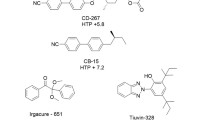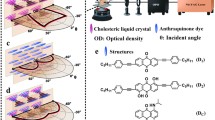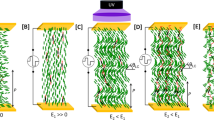Abstract
We reported here the fabrication of the electrically tunable infrared (IR) reflectors based on the polymer stabilized cholesteric liquid crystal (PSCLC) with negative dielectric anisotropy. A systematic study of the influence of cell gap on the electrically tunable reflection bandwidth was performed. When a direct current (DC) electric field was applied, the reflection bandwidth red shifted in the cells with small cell gap, whereas the bandwidth broadening was observed in the cells with large cell gap. It is therefore reasonable to deduct that the reflection is dictated by the pitch gradient steepness which strongly relies on the cell thickness. The results reveal that for making PSCLC based IR reflector windows with electrically induced bandwidth broadening, a minimal cell gap thickness is required. The resulted IR reflectors possess a short native switching time and long-term operation stability, and are potentially applicable as smart energy saving windows in buildings and automobiles.
摘要
本文报道了基于聚合物胆甾相液晶的、 可电场调控的红外反射器件的制备, 并系统研究了器件厚度对器件性能的影响. 即施加直流电场后, 厚度较小的器件的反射带宽仅发生红移; 厚度较大的器件的反射带宽增宽. 这种现象是由于不同厚度的胆甾相液晶薄膜中不同的螺距梯度导致的. 本工作的研究结果表明在制备基于聚合物胆甾相液晶的电控红外反射器件时, 厚度是决定反射性能的重要因素. 由于该红外反射器件具有较快的响应时间和较好的工作稳定性, 在建筑和汽车等的节能窗领域有较好的应用前景.
Similar content being viewed by others
References
LaFrance M. In Energy Technol Pol Div IEA. 2013
Good C, Chen J, Dai Y, et al. Hybrid photovoltaic-thermal systems in buildings—a review. Energ Procedia, 2015, 70: 683–690
Ding J, Yan Q. Progress in organic-inorganic hybrid halide perovskite single crystal: growth techniques and applications. Sci China Mater, 2017, 60: 1063–1078
Debije MG, Verbunt PPC. Thirty years of luminescent solar concentrator research: solar energy for the built environment. Adv Energ Mater, 2012, 2: 12–35
Loonen RCGM, Trčka M, Cóstola D, et al. Climate adaptive building shells: state-of-the-art and future challenges. Renew Sustain Energ Rev, 2013, 25: 483–493
Liu Y, Zhang H, Sun Y, et al. A-D-A-type small molecular acceptor with one hexyl-substituted thiophene as π bridge for fullerene-free organic solar cells. Sci China Mater, 2017, 60: 49–56
Cai Y, Guo X, Sun X, et al. A twisted monomeric perylenediimide electron acceptor for efficient organic solar cells. Sci China Mater, 2016, 59: 427–434
Ochoa CE, Aries MBC, van Loenen EJ, et al. Considerations on design optimization criteria for windows providing low energy consumption and high visual comfort. Appl Energ, 2012, 95: 238–245
Gutierrez MP, Lee LP. Multiscale design and integration of sustainable building functions. Science, 2013, 341: 247–248
Wang J, Zhang L, Yu L, et al. A bi-functional device for selfpowered electrochromic window and self-rechargeable transparent battery applications. Nat Commun, 2014, 5: 4921
Granqvist CG. Electrochromics for smart windows: oxide-based thin films and devices. Thin Solid Films, 2014, 564: 1–38
Kwon HK, Lee KT, Hur K, et al. Optically switchable smart windows with integrated photovoltaic devices. Adv Energ Mater, 2015, 5: 1401347
Runnerstrom EL, Llordés A, Lounis SD, et al. Nanostructured electrochromic smart windows: traditional materials and NIR-selective plasmonic nanocrystals. Chem Commun, 2014, 50: 10555–10572
Shibaev V, Bobrovsky A, Boiko N. Light-responsive chiral photochromic liquid crystalline polymer systems. J PhotoChem Photo-Biol A-Chem, 2003, 155: 3–19
Yeh MH, Lin L, Yang PK, et al. Motion-driven electrochromic reactions for self-powered smart window system. ACS Nano, 2015, 9: 4757–4765
Lin W, Zhao Q, Sun H, et al. An electrochromic phosphorescent iridium(iii) complex for information recording, encryption, and decryption. Adv Opt Mater, 2015, 3: 368–375
Wang F, Li K, Song P, et al. Photoinduced pitch gradients and the reflection behaviour of the broadband films: influence of dye concentration, light intensity, temperature and monomer concentration. Liquid Crysts, 2012, 39: 707–714
Wu CC, Liou JC, Diao CC. Self-powered smart window controlled by a high open-circuit voltage InGaN/GaN multiple quantum well solar cell. Chem Commun, 2015, 51: 12625–12628
Xiang J, Li Y, Li Q, et al. Electrically tunable selective reflection of light from ultraviolet to visible and infrared by heliconical cholesterics. Adv Mater, 2015, 27: 3014–3018
Khandelwal H, Loonen RCGM, Hensen JLM, et al. Application of broadband infrared reflector based on cholesteric liquid crystal polymer bilayer film to windows and its impact on reducing the energy consumption in buildings. J Mater Chem A, 2014, 2: 14622–14627
Granqvist CG. Transparent conductors as solar energy materials: A panoramic review. Sol Energ Mater Sol Cells, 2007, 91: 1529–1598
Yang H, Mishima K, Matsuyama K, et al. Thermally bandwidthcontrollable reflective polarizers from (polymer network/liquid crystal/chiral dopant) composites. Appl Phys Lett, 2003, 82: 2407–2409
Guo R, Li K, Cao H, et al. Chiral polymer networks with a broad reflection band achieved with varying temperature. Polymer, 2010, 51: 5990–5996
Llordés A, Garcia G, Gazquez J, et al. Tunable near-infrared and visible-light transmittance in nanocrystal-in-glass composites. Nature, 2013, 500: 323–326
Xianyu H, Faris S, Crawford GP. In-plane switching of cholesteric liquid crystals for visible and near-infrared applications. Appl Opt, 2004, 43: 5006–5015
Khandelwal H, Schenning APHJ, Debije MG. Infrared regulating smart window based on organic materials. Adv Energ Mater, 2017, 7: 1602209
Khandelwal H, Timmermans GH, Debije MG, et al. Dual electrically and thermally responsive broadband reflectors based on polymer network stabilized chiral nematic liquid crystals: the role of crosslink density. Chem Commun, 2016, 52: 10109–10112
Khandelwal H, Debije MG, White TJ, et al. Electrically tunable infrared reflector with adjustable bandwidth broadening up to 1100 nm. J Mater Chem A, 2016, 4: 6064–6069
Khandelwal H, Loonen RCGM, Hensen JLM, et al. Electrically switchable polymer stabilised broadband infrared reflectors and their potential as smart windows for energy saving in buildings. Sci Rep, 2015, 5: 11773
Bahr C, Kitzerow H-S. Chirality in Liquid Crystals. New York: Springer, 2001
Wu S-T, Yang D-K. Reflective Liquid Crystal Displays. New York: Wiley, 2001
Kelkerund R. Hatz. Handbook of Liquid Crystals. Verlag Chemie, Weinheim 1980. XVIII, 917 S., geb. DM 420.00. Angew Chem, 1980, 92: 667–668
Tondiglia VP, Natarajan LV, Bailey CA, et al. Bandwidth broadening induced by ionic interactions in polymer stabilized cholesteric liquid crystals. Opt Mater Express, 2014, 4: 1465–1472
Tondiglia VT, Natarajan LV, Bailey CA, et al. Electrically induced bandwidth broadening in polymer stabilized cholesteric liquid crystals. J Appl Phys, 2011, 110: 053109–053109
Nemati H, Liu S, Zola RS, et al. Mechanism of electrically induced photonic band gap broadening in polymer stabilized cholesteric liquid crystals with negative dielectric anisotropies. Soft Matter, 2015, 11: 1208–1213
Lee KM, Tondiglia VP, Lee T, et al. Large range electrically-induced reflection notch tuning in polymer stabilized cholesteric liquid crystals. J Mater Chem C, 2015, 3: 8788–8793
Lee KM, Tondiglia VP, Godman NP, et al. Blue-shifting tuning of the selective reflection of polymer stabilized cholesteric liquid crystals. Soft Matter, 2017, 13: 5842–5848
Yu M, Wang L, Nemati H, et al. Effects of polymer network on electrically induced reflection band broadening of cholesteric liquid crystals. J Polym Sci Part B-Polym Phys, 2017, 55: 835–846
Chu Y, Yin Z, Sha J, et al. Regulation and control of polymer network deformation in reverse-mode polymer-stabilised cholesteric texture. Liquid Crysts, 2017, 44: 688–694
Lu H, Song Z, Zhang J, et al. The influence of helical twisting power on the electro-optical properties of reverse-mode polymerstabilised cholesteric texture. Liquid Crysts, 2014, 41: 615–620
Lee KM, Tondiglia VP, McConney ME, et al. Color-tunable mirrors based on electrically regulated bandwidth broadening in polymer-stabilized cholesteric liquid crystals. ACS Photonics, 2014, 1: 1033–1041
Heilmeier GH, Dynamic scattering: A new electrooptic effect in certain classes of nematic liquid crystals. Proc. of IEEE 1968, 56: 1162–1171
Acknowledgements
This work was supported by the National Natural Science Foundation of China (51503070, 51561135014, U1501244), Guangdong Innovative Research Team Program under Grant [2013C102], Science and technology project of Guangdong Province [2015B090913004, 2016B090909001], Science and technology Project of Shenzhen [JSGG201704143009027], Guangdong Provincial Key Laboratory of Optical Information Materials and Technology under Grant [2017B030301007] and the 111 Project.
Author information
Authors and Affiliations
Corresponding author
Additional information
Xiaowen Hu was born in 1987 and joined South China Normal University in 2015. He completed his PhD in materials physics and chemistry at South China University of Technology in 2014. His research is related to organic optoelectronic devices such as polymer solar cells, light shutters and infrared reflectors basd on liquid crystal polymer.
Guofu Zhou was born in 1964 and became full professor of South China Normal University in 2014. He completed his dual PhD in materials science at Chinese academy of science in 1991, and in Physics at University of Amsterdam in 1994, respectively. His research is related to the field of micro/nano optoelectronic materials, devices and flat panel displays, mainly engaged in research on optoelectronic materials and devices.
Rights and permissions
About this article
Cite this article
Hu, X., de Haan, L.T., Khandelwal, H. et al. Cell thickness dependence of electrically tunable infrared reflectors based on polymer stabilized cholesteric liquid crystals. Sci. China Mater. 61, 745–751 (2018). https://doi.org/10.1007/s40843-017-9163-0
Received:
Accepted:
Published:
Issue Date:
DOI: https://doi.org/10.1007/s40843-017-9163-0




